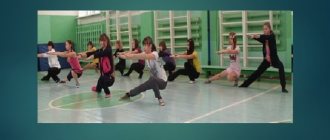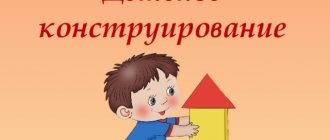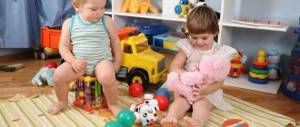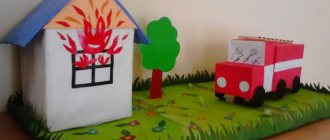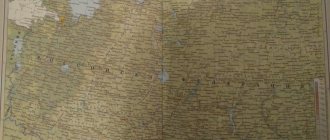Applications made from natural materials
Even young children can make products in the form of appliqués from leaves, twigs, and plant seeds.
Applique is a technique for creating an image by attaching details to the background.
Panel of cone scales
Using a knife, carefully cut off all the scales from the cone, the edges of which will need to be slightly trimmed. Cut out a small circle from cardboard - this will be the core of the flower. Carefully glue the first row of scales along the very edge of the workpiece, the second row of scales should be placed inside the first at a slight angle to the cardboard. Continue gluing rows until there is very little space left in the center - you will need to attach several scales vertically there.
To make a stem, cut a strip of brown paper, coat it with glue and wrap it around a thin wire. The finished stem can be beautifully bent, giving it the desired shape. You can also use a small tree branch as a stem. After the flower and stem are dry, you can coat them with varnish and glue them to a cardboard base. The panel is ready, all that remains is to insert it into a beautiful frame.
DIY basket of pine cones
Panel made of seeds
Make several stems by wrapping strips of colored paper around the wire and glue them to the cardboard base. You can simply draw them with a pencil or paints. Take the seeds (it is better that they are small, but from different fruits, for example, cherry and orange) and carefully glue them, placing them next to the stems, so that it looks like berry branches. You can complement the composition by gluing several small pine cones at the bottom of the panel.
Basket and berries from walnuts
Take the walnut shells and glue them to the cardboard base, trying to make it look like a basket. Make a handle from the same material. In the resulting basket you can place flowers made from cone scales.
Using walnut shells, you can make many other beautiful applications.
Other applications from tree leaves and twigs
Consultation for educators Construction from natural materials
Consultation for educators
Construction from natural materials
The term "construction"
comes from the Latin word construere - which means creating a model, constructing, bringing parts into a certain conformity.
Construction is a productive activity because aimed at obtaining a specific product.
The position of the author Larisa Alekseevna Paramonova is taken as the basis for determining the main features of children's design (show book)
There are two types of design: technical and artistic.
Technical types include:
-construction from building materials (wooden, painted and unpainted geometric parts);
— from construction kit parts (different materials: plastic, wood, metal and different methods of fastening parts);
— from large-sized modular blocks (floor building material or soft modules).
Artistic types include:
- paper construction
- from natural material
A special place is occupied by computer design and creation of structures
from waste material. They can be both technical and artistic in nature, depending on the purpose of the activity.
That. Children's construction is an activity in which children create various play crafts and buildings from various materials (paper, cardboard, wood, special construction kits and construction sets).
The constructive activity of children is close to the constructive and technical activity of adults. The product of children's activity does not yet have social significance; the child does not contribute anything new either to the material or cultural values of society. However, the guidance of children's activities by adults has the most beneficial effect on the labor education of preschoolers.
Children's design products, as a rule, are intended for practical use in games, theatrical activities, for decorating groups and areas, and are used as gifts.
The existence of two types of children's design - artistic and technical, each of which has its own characteristics, requires a differentiated approach to managing them.
Construction from natural materials
Natural material can be used as a building material for children's games, starting from the second youngest group. This is primarily sand, snow, water. Children become familiar with the properties of materials. They learn that sand is free-flowing, but you can sculpt from raw sand, water can be poured into different dishes, and in the cold it freezes, etc.
Buildings are made from raw sand, for example, a road, a house, bridges, using special forms - pies, etc.
At an older age, children freeze colored water, preparing colored pieces of ice with which to decorate the area.
Various buildings, snowmen, animal figurines, etc. are made from snow.
Construction from natural materials is introduced in most educational programs from the middle group. Children make toys and crafts from natural materials: branches, bark, leaves, chestnuts, pine cones, spruce, nut shells, straw, acorns, maple seeds, etc. It is important to choose the material so that in different age groups it is complemented and accessible.
The peculiarity of crafts made from this material is that its natural shape is used. The teacher’s task is to teach how to create a variety of artistic images, which are based on mastering generalized methods of creating an image based on clarity. (make a craft and on the board there are only manufacturing diagrams using different materials).
It is important to teach to feel the specifics of natural material, its color, texture.
To develop the ability to notice similarities in natural materials with objects of reality.
Main stages of training:
Stage 1
— teach how to analyze natural materials as the basis for future crafts. Show techniques for making new images, such as building or adding, removing unnecessary things, changing spatial position. Create the very image of the object and its parts, the simplest movements.
(fish, hedgehog)
It is important that the child reason, find the name, try to say who it resembles. (What is similar to what)
You can offer tasks of a problematic nature. (for example, pieces of tree bark of different shapes and sizes and you need to figure out what will happen. There is material, but there is no name for the work).
An interesting technique is to carry out a craft with a continuation - during the lesson the child came up with an object (he made a forest man from a piece of bark), and at the next lesson combine the crafts into compositions. (3-4 different works are combined into a single plot).
Stage 2-
developing the ability to perform crafts by supplementing them with various details. (frog) (Give Lesovich a basket, a cane, a bell, a friend - a bunny, a dog.). It is important to teach how to first formulate an idea for your craft.
Strengthen this similarity and expressiveness by additional processing using tools, connecting parts (plasticine, glue, inserting each other).
Stage 3 - plot construction should prevail (147-)
It is important when conducting classes to choose methods, such as the use of variable samples. Creating problematic situations. ...
That. When learning to design from natural materials, there must be the correct guidance of an adult: an individual approach, choice of motivation, cooperation. It is important that design training contributes to the development of creative imagination.
Crafts made from natural and waste materials
Walnut shell boat
Take a walnut shell, attach it to the cardboard, trace the outline and cut it out. This will be the deck of the ship. In the center of the workpiece, use an awl to make a hole for attaching the mast. Place a small pebble in the shell and then glue on the deck. The mast can be made from an ordinary match, and the sail can be cut from double-sided colored paper. Connect the parts of the craft together using glue.
Other unusual crafts
Construction as a type of children's creativity
Definition 1
Construction is the process of constructing an object, bringing various parts, elements and objects into a certain relative position.
Construction is a type of children's activity during which the child constructs a specific object (according to a scheme, plan, spontaneously, etc.). Construction occurs by composing parts or elements (cubes, building material, natural material, waste material, etc.) in any order, depending on the type of construction.
Construction is of great importance in the development of a preschool child, in his mastery of various types of practical activities. By its nature, construction is a productive type of children's activity.
The main feature of design is that it is creative in nature, as it is aimed at obtaining a specific expected product. In addition, design is also defined as a special experimental research and search activity aimed at obtaining a total product consisting of individual elements. Also, a number of researchers consider design from a creative point of view.
Finished works on a similar topic
- Course work Designing from natural materials as a means of developing children's creativity 420 rub.
- Abstract Construction from natural materials as a means of developing children's creativity 240 rub.
- Test work Construction from natural materials as a means of developing children's creativity 190 rub.
Receive completed work or specialist advice on your educational project Find out the cost
In the design process, the child uses a variety of materials that have different characteristics (size, shape, tactile sensations, etc.). By constructing from various materials, the child learns to generalize, masters universal skills for constructing a single whole from a set of elements.
Definition 2
Creative design is a complex system of practical and mental actions aimed at solving a specific constructive problem.
Creativity in construction consists in the fact that a child, while engaged in construction, carries out such processes as thinking and planning his upcoming activities, translating an incipient mental concept into a real creative product.
Note 1
Thus, children's creative construction has a comprehensive impact on the child's development. It promotes the formation of a variety of practical skills, as well as the development of speech, memory, thinking, imagination and fantasy of the child.
Too lazy to read?
Ask a question to the experts and get an answer within 15 minutes!
Ask a Question
